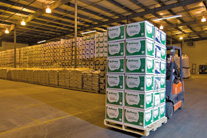
News
The science behind inoculant manufacturing
A look at what it takes to get inoculants from the laboratory to the field.
November 26, 2007 By Top Crop Manager
Anyone who has made sourdough bread, with its starter yeast cultures, has a
basic understanding of some of the principles involved in manufacturing inoculants
– although very basic. Once a new strain of inoculant has been identified,
the safe storage, multiplication, formulation and delivery of that strain to
thousands of farmers take a lot of science.
 |
| Deanna Zimmerman with Philom Bios checks on a mother culture bottle, stored in a minus 80 degrees C freezer. |
"We have a strong responsibility to deliver an inoculant to growers that
will perform in the field," explains Greg Holloway, manufacturing manager
with Philom Bios at Saskatoon, Saskatchewan. "The inoculant product has
to be absolutely reliable, so we put a lot of effort into research and development
to make sure the manufacturing process delivers high numbers of healthy organisms
to the farmer."
The steps in manufacturing are relatively straightforward. Take the bacterial
or fungal strain, multiply it, formulate into the product, package and store
it. The execution of those steps, though, is much more difficult.
"The challenge is working with a living organism. Not only do we have
to keep it alive from the laboratory to the field, but we have to find the most
effective processes to amplify it up into the quantities that we need for the
commercial farmer," explains Holloway. "We also have to make sure
other bacteria aren't introduced that might harm the production process."
 |
| Greg Holloway checks on a starter culture flask. |
Amplification is a blend of science and art
The stock or 'mother' culture contains the strain of bacteria that starts the
manufacturing process. These strains are identified by researchers and are proven
to be the most efficient strain of rhizobia possible when it comes to nodulation
and nitrogen fixation of specific crops. Some companies use strains that are
commonly available from public research institutions. Philom Bios, though, conducts
its own strain research to develop better performing strains that are well suited
to local growing conditions.
Once identified, the mother culture is stored at minus 80 degrees C: the storage
chambers for the mother cultures somewhat resemble Fort Knox in terms of security
and back-up. Lose the mother culture and the entire research and development
process is back to square one.
To begin the manufacturing process, the mother culture is taken from deep freeze
storage, thawed and multiplied into starter cultures. Holloway says there are
several ways to multiply the mother culture into starter cultures. Small fermenters
and shake flasks are two common methods.
 |
| The starter culture is the first step in amplifying up the mother culture. |
"If you have ever made sourdough bread, you would understand the principle
behind culturing bacteria. With sourdough bread, you always have a starter culture
of bacteria on hand. When you're ready to make bread, you increase that culture
into the quantity that you need for your batch of bread with enough left over
to maintain the mother culture," explains Holloway.
From these small starter cultures, subsequent cultures are amplified into commercial
batch sizes with the use of a fermenter. Essentially, the bacteria have nutrients
to feed on in some sort of slurry solution and will multiply into millions and
millions of bacteria.
That might seem like a simple process, but Holloway says companies spend a
lot of time looking for the best medium to use for the starter culture. The
type of nutrients used, the temperature, the amount of gas exchange in the fermenter
and the time it takes can vary from strain to strain.
 |
| Greg Holloway checks on a small batch fermenter used to amplify the rhizobia bacteria up to commercial quantities. |
"The process can be different for each strain. Strains are somewhat like
people. We are all of the same species, but we are genetically different,"
he explains.
The Philom Bios fermenters, installed at their new manufacturing facility in
Saskatoon, produce large batches of bacteria for the formulation line. For example,
one batch can produce 2500 bags of N-Prove peat formulation – or enough
to inoculate about 50,000 acres of medium-sized peas or 61,000 acres of large
green lentils.
After the amplification stage, the bacteria go to the production lines for
packaging into peat, liquid or granular formulations. Here again, much effort
is put into developing the best type of carrier for the bacteria to ensure they
remain healthy and viable. From there, the product goes into refrigerated storage
awaiting shipment to farm supply retailers in late winter and early spring.
Holloway says that every step in the manufacturing process is carefully controlled
with quality assurance tests along the way to ensure the bacterial strain remains
viable in the quantities necessary to inoculate the seed at recommended rates.
 |
| Inoculant is stored in a climate controlled warehouse. |
"The real key to the whole thing is the high level of commitment we have
from our people. We have 20 tech lab staff, who cover the range from strain
research and development, making mother and starter cultures, and doing quality
assurance – this itself directly involves about six of those staff –
and another 20 to 30 people in production who are totally committed to making
sure the product line meets quality standards," says Holloway.
Philom Bios conducts more than 100,000 quality assurance laboratory tests each
year to ensure that each product meets high internal standards. "When a
farmer receives the product, we're confident that he is getting a product that
will do exactly what it is supposed to do," explains Holloway.